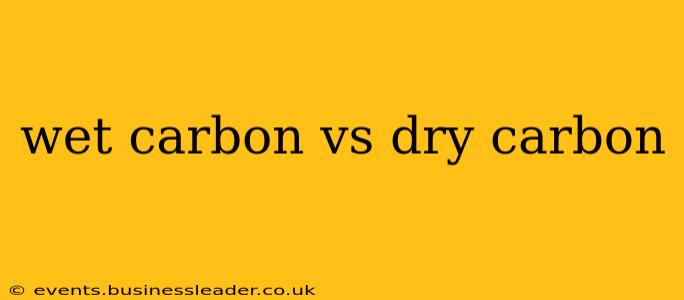Carbon fiber composites are renowned for their exceptional strength-to-weight ratio, making them ideal for high-performance applications in aerospace, automotive, and sporting goods. However, within the realm of carbon fiber, there's a key distinction: wet carbon versus dry carbon. Understanding the differences between these two manufacturing methods is crucial for selecting the right material for a specific application. This article will explore the key characteristics, manufacturing processes, and applications of both wet and dry carbon composites.
What is Wet Carbon?
Wet carbon refers to a composite manufacturing process where the carbon fibers are impregnated with resin during the layup process. The resin is typically applied to the fibers individually, or as pre-impregnated sheets (prepreg), just before or as the fibers are placed into the mold. This "wet" aspect means the resin is still in a liquid state when the composite is cured. The curing process, often involving heat and pressure, hardens the resin, binding the fibers together and creating the final composite part.
Advantages of Wet Carbon:
- Cost-effective: Wet layup is generally less expensive than dry layup, particularly for smaller production runs, as it requires simpler equipment and less precise control.
- Versatility: Wet layup allows for greater flexibility in shaping complex geometries.
- Repair-friendly: Damaged wet carbon parts can often be more easily repaired than dry carbon parts.
Disadvantages of Wet Carbon:
- Lower Strength and Stiffness: The presence of excess resin often leads to a slightly lower strength-to-weight ratio compared to dry carbon.
- Longer Cure Time: The curing process takes longer than with dry carbon, impacting production efficiency.
- Inconsistent Resin Distribution: Achieving a uniform distribution of resin throughout the composite can be challenging, potentially leading to variations in strength and performance.
What is Dry Carbon?
Dry carbon, also known as prepreg carbon fiber, utilizes pre-impregnated carbon fiber sheets (prepreg) that contain a precisely measured amount of resin. These sheets are carefully laid up in the mold, and then cured under heat and pressure. The "dry" aspect refers to the fact that the resin is already partially cured within the prepreg material before the layup begins. This pre-impregnation ensures a consistent resin distribution.
Advantages of Dry Carbon:
- Higher Strength and Stiffness: The precise resin content and careful layup result in a higher strength-to-weight ratio and improved stiffness.
- Faster Cure Time: The pre-cured resin in prepreg requires less curing time than wet layup.
- Improved Consistency: The consistent resin distribution leads to more uniform properties throughout the composite part.
- More Predictable Performance: Dry carbon consistently provides higher predictability in performance characteristics.
Disadvantages of Dry Carbon:
- Higher Cost: Prepreg materials are more expensive than the raw materials used in wet layup.
- Specialized Equipment: Dry layup requires more specialized equipment and trained personnel.
- Less Versatile for Complex Shapes: While achievable, crafting very complex shapes with prepreg can be more challenging.
Wet Carbon vs. Dry Carbon: Which is Better?
The "better" option depends entirely on the specific application and priorities. Wet carbon is often preferred when cost is a primary concern, or when complex geometries are required, and where some sacrifice in strength is acceptable. Dry carbon is the superior choice for high-performance applications where maximum strength, stiffness, and consistent performance are critical, even if it comes at a higher cost.
What are the differences in the manufacturing processes?
The core difference lies in the resin application timing. Wet carbon involves resin application during the layup, while dry carbon uses pre-impregnated sheets where the resin is already partially cured. This affects the curing time, cost, and final product properties.
Which is stronger, wet carbon or dry carbon?
Dry carbon generally offers higher strength and stiffness due to its precise resin content and uniform distribution achieved through prepreg materials.
What is the difference in cost between wet carbon and dry carbon?
Dry carbon is significantly more expensive due to the cost of prepreg materials and the specialized equipment and expertise needed for its processing.
Which is better for bicycle frames?
For high-end bicycle frames, dry carbon is typically preferred due to its superior strength-to-weight ratio and consistent performance, crucial for achieving optimal ride quality and durability. However, many budget-friendly bikes utilize wet-layup carbon fiber construction.
Conclusion
Choosing between wet and dry carbon requires careful consideration of factors like budget, performance requirements, and the complexity of the design. While wet carbon offers a cost-effective solution for less demanding applications, dry carbon stands out for its superior strength, consistency, and performance in high-stakes industries. Understanding the nuances of each process is vital for making informed decisions in material selection.
